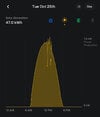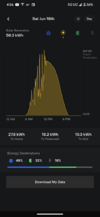The longer I study my first years’ solar production in the Tesla App, the more fascinating I’m finding the subject!
it’s enlightening seeing evidence that contradicts what I formerly believed about seasonal solar production variation.
Specifically, I got my Solar panels and battery storage in March. In April, I received my PTO and could then start to get an idea of my average production from month to month. In April and May I was producing almost 70 Kwh a day and was ecstatic! Thinking how far above the quoted performance that was. My thinking was that if it was making this much production in April and May; June, July, and August would be unbelievably good because the sun angle would be even more optimal than in Spring.
As the summer months turned over, my overall production slowly decreased. The most obvious change of course was the blistering heat. I went from clipping at the inverter max for almost 4 hours a day in May and June to just 3 then 2, and 1 in July, Aug and Sep consecutively. The shoulders of the solar curve were broader, put the peak was very curtailed. I then became more familiar with how temperature degrades panel efficiency significantly, noting also that April and May months were extremely bright with almost no cloud cover and extremely cold for spring.
I got a further very eye opening example on this one day at the end of October (when the sun angle is very unfavorable) but during the afternoon there were very abrupt, thick cloud cover moments; a very hot midday, then suddenly a 15 minute period of very thick cloud cover where the temp dropped significantly, then a sudden burst of bright, clear sky where the temp shot back up. I looked at my solar app at those exact moments, and it reported I was producing very close to clipping production!
But as I watched, the numbers very quickly shrank until it ended up following the typical October profile for the normally very hot days. So I ended up with these weird spikes where production dropped to half for a few minutes, but then as the cloud cover broke, shot up to close to production max past where it normally would be if there were no clouds, then quickly taper down to normal October profile as the the oanels, I’m assuming heated up again quickly.
It made me consider two things. 1) Solar panels are far more affected by extreme heat than I thought (I thought it was only something like 1-2% total) and 2) If you could supercool panels without somehow using any power, you could get astoundingly more production out of a pv cell.
My first thought was a solar panel array under a waterfall in such a way as a thin perfectly clear sheet of ice cold mountain water was constantly running evenly across all the panels lol!
it’s enlightening seeing evidence that contradicts what I formerly believed about seasonal solar production variation.
Specifically, I got my Solar panels and battery storage in March. In April, I received my PTO and could then start to get an idea of my average production from month to month. In April and May I was producing almost 70 Kwh a day and was ecstatic! Thinking how far above the quoted performance that was. My thinking was that if it was making this much production in April and May; June, July, and August would be unbelievably good because the sun angle would be even more optimal than in Spring.
As the summer months turned over, my overall production slowly decreased. The most obvious change of course was the blistering heat. I went from clipping at the inverter max for almost 4 hours a day in May and June to just 3 then 2, and 1 in July, Aug and Sep consecutively. The shoulders of the solar curve were broader, put the peak was very curtailed. I then became more familiar with how temperature degrades panel efficiency significantly, noting also that April and May months were extremely bright with almost no cloud cover and extremely cold for spring.
I got a further very eye opening example on this one day at the end of October (when the sun angle is very unfavorable) but during the afternoon there were very abrupt, thick cloud cover moments; a very hot midday, then suddenly a 15 minute period of very thick cloud cover where the temp dropped significantly, then a sudden burst of bright, clear sky where the temp shot back up. I looked at my solar app at those exact moments, and it reported I was producing very close to clipping production!
But as I watched, the numbers very quickly shrank until it ended up following the typical October profile for the normally very hot days. So I ended up with these weird spikes where production dropped to half for a few minutes, but then as the cloud cover broke, shot up to close to production max past where it normally would be if there were no clouds, then quickly taper down to normal October profile as the the oanels, I’m assuming heated up again quickly.
It made me consider two things. 1) Solar panels are far more affected by extreme heat than I thought (I thought it was only something like 1-2% total) and 2) If you could supercool panels without somehow using any power, you could get astoundingly more production out of a pv cell.
My first thought was a solar panel array under a waterfall in such a way as a thin perfectly clear sheet of ice cold mountain water was constantly running evenly across all the panels lol!




